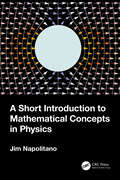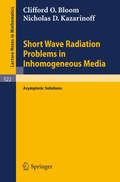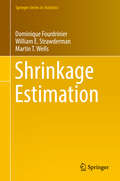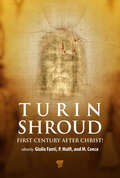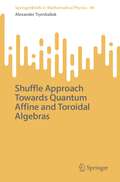- Table View
- List View
A Short Introduction to Mathematical Concepts in Physics
by Jim NapolitanoMathematics is the language of physics and yet, mathematics is an enormous subject. This textbook provides an accessible and concise introduction to mathematical physics for undergraduate students taking a one semester course. It assumes the reader has studied a year of introductory physics and three semesters of basic calculus, including some vector calculus, but no formal training in differential equations or matrix algebra. It equips readers with the skills and foundational knowledge they need for courses that follow in classical mechanics, electromagnetism, quantum mechanics, and thermal physics. This book exposes students early on to the kinds of mathematical manipulations they will need in upper-level courses in physics. It can also serve as a useful reference for their further studies. Key features: Accompanied by homework problems and a solutions manual for instructors, available upon qualifying course adoption Bridges the gap between calculus and physics, explaining fundamental mathematics (differentiation, integration, infinite series) in physical terms Explores quick extensions into mathematics useful in physics, not typically taught in math courses, including the Gamma Function, hyperbolic functions, Gaussian integrals, Legendre polynomials, functions of a complex variable, and probability distribution functions
A Short Introduction to Mathematical Concepts in Physics
by Jim NapolitanoMathematics is the language of physics and yet, mathematics is an enormous subject. This textbook provides an accessible and concise introduction to mathematical physics for undergraduate students taking a one semester course. It assumes the reader has studied a year of introductory physics and three semesters of basic calculus, including some vector calculus, but no formal training in differential equations or matrix algebra. It equips readers with the skills and foundational knowledge they need for courses that follow in classical mechanics, electromagnetism, quantum mechanics, and thermal physics. This book exposes students early on to the kinds of mathematical manipulations they will need in upper-level courses in physics. It can also serve as a useful reference for their further studies. Key features: Accompanied by homework problems and a solutions manual for instructors, available upon qualifying course adoption Bridges the gap between calculus and physics, explaining fundamental mathematics (differentiation, integration, infinite series) in physical terms Explores quick extensions into mathematics useful in physics, not typically taught in math courses, including the Gamma Function, hyperbolic functions, Gaussian integrals, Legendre polynomials, functions of a complex variable, and probability distribution functions
A Short Introduction to Partial Differential Equations (Cms/caims Books In Mathematics Ser. #11)
by Arian NovruziA Short Introduction to Perturbation Theory for Linear Operators
by Tosio KatoThis book is a slightly expanded reproduction of the first two chapters (plus Introduction) of my book Perturbation Theory tor Linear Operators, Grundlehren der mathematischen Wissenschaften 132, Springer 1980. Ever since, or even before, the publication of the latter, there have been suggestions about separating the first two chapters into a single volume. I have now agreed to follow the suggestions, hoping that it will make the book available to a wider audience. Those two chapters were intended from the outset to be a comprehen sive presentation of those parts of perturbation theory that can be treated without the topological complications of infinite-dimensional spaces. In fact, many essential and. even advanced results in the theory have non trivial contents in finite-dimensional spaces, although one should not forget that some parts of the theory, such as those pertaining to scatter ing. are peculiar to infinite dimensions. I hope that this book may also be used as an introduction to linear algebra. I believe that the analytic approach based on a systematic use of complex functions, by way of the resolvent theory, must have a strong appeal to students of analysis or applied mathematics, who are usually familiar with such analytic tools.
A Short Introduction to Preferences: Between AI and Social Choice (Synthesis Lectures on Artificial Intelligence and Machine Learning)
by Francesca Bellet Kristen Brent HabrardComputational social choice is an expanding field that merges classical topics like economics and voting theory with more modern topics like artificial intelligence, multiagent systems, and computational complexity. This book provides a concise introduction to the main research lines in this field, covering aspects such as preference modelling, uncertainty reasoning, social choice, stable matching, and computational aspects of preference aggregation and manipulation. The book is centered around the notion of preference reasoning, both in the single-agent and the multi-agent setting. It presents the main approaches to modeling and reasoning with preferences, with particular attention to two popular and powerful formalisms, soft constraints and CP-nets. The authors consider preference elicitation and various forms of uncertainty in soft constraints. They review the most relevant results in voting, with special attention to computational social choice. Finally, the book considers preferences in matching problems. The book is intended for students and researchers who may be interested in an introduction to preference reasoning and multi-agent preference aggregation, and who want to know the basic notions and results in computational social choice. Table of Contents: Introduction / Preference Modeling and Reasoning / Uncertainty in Preference Reasoning / Aggregating Preferences / Stable Marriage Problems
Short-Memory Linear Processes and Econometric Applications
by Kairat T. MynbaevThis book serves as a comprehensive source of asymptotic results for econometric models with deterministic exogenous regressors. Such regressors include linear (more generally, piece-wise polynomial) trends, seasonally oscillating functions, and slowly varying functions including logarithmic trends, as well as some specifications of spatial matrices in the theory of spatial models. The book begins with central limit theorems (CLTs) for weighted sums of short memory linear processes. This part contains the analysis of certain operators in Lp spaces and their employment in the derivation of CLTs. The applications of CLTs are to the asymptotic distribution of various estimators for several econometric models. Among the models discussed are static linear models with slowly varying regressors, spatial models, time series autoregressions, and two nonlinear models (binary logit model and nonlinear model whose linearization contains slowly varying regressors). The estimation procedures include ordinary and nonlinear least squares, maximum likelihood, and method of moments. Additional topical coverage includes an introduction to operators, probabilities, and linear models; Lp-approximable sequences of vectors; convergence of linear and quadratic forms; regressions with slowly varying regressors; spatial models; convergence; nonlinear models; and tools for vector autoregressions.
Short-Memory Linear Processes and Econometric Applications
by Kairat T. MynbaevThis book serves as a comprehensive source of asymptotic results for econometric models with deterministic exogenous regressors. Such regressors include linear (more generally, piece-wise polynomial) trends, seasonally oscillating functions, and slowly varying functions including logarithmic trends, as well as some specifications of spatial matrices in the theory of spatial models. The book begins with central limit theorems (CLTs) for weighted sums of short memory linear processes. This part contains the analysis of certain operators in Lp spaces and their employment in the derivation of CLTs. The applications of CLTs are to the asymptotic distribution of various estimators for several econometric models. Among the models discussed are static linear models with slowly varying regressors, spatial models, time series autoregressions, and two nonlinear models (binary logit model and nonlinear model whose linearization contains slowly varying regressors). The estimation procedures include ordinary and nonlinear least squares, maximum likelihood, and method of moments. Additional topical coverage includes an introduction to operators, probabilities, and linear models; Lp-approximable sequences of vectors; convergence of linear and quadratic forms; regressions with slowly varying regressors; spatial models; convergence; nonlinear models; and tools for vector autoregressions.
The Short-Run Approach to Long-Run Equilibrium in Competitive Markets: A General Theory with Application to Peak-Load Pricing with Storage (Lecture Notes in Economics and Mathematical Systems #684)
by Anthony Horsley Andrew J. WrobelThe authors present a new formal framework for finding the long-run competitive market equilibrium through short-run equilibria by exploiting the operating policies and plant valuations. This “short-run approach” develops ideas of Boiteux and Koopmans. Applied to the peak-load pricing of electricity generated by thermal, hydro and pumped-storage plants, it gives a sound and practical method of valuing the fixed assets—in this case, the river flows and the geological sites suitable for reservoirs. Its main mathematical basis is the producer’s short-run profit maximization programme and its dual; their solutions have relatively simple forms that can greatly ease the fixed-point problem of solving for the general equilibrium. Since the optimal values (profit and cost functions) are usually nondifferentiable—this is so when there are joint costs of production such as capacity constraints—nonsmooth calculus is employed to resolve long-standing discrepancies between textbook theory and industrial reality by giving subdifferential extensions of basic results of microeconomics, including the Wong-Viner Envelope Theorem.
Short Wave Radiation Problems in Inhomogeneous Media: Asymptotic Solutions (Lecture Notes in Mathematics #522)
by C. O. Bloom N. D. KazarinoffShortcut to Superconductivity: Superconducting Electronics via COMSOL Modeling
by Armen GulianThis accessible textbook offers a novel, concept-led approach to superconducting electronics, using the COMSOL Multiphysics software to help describe fundamental principles in an intuitive manner.Based on a course taught by the author and aimed primarily at engineering students, the book explains concepts effectively and efficiently, uncovering the “shortcut” to understanding each topic, enabling readers to quickly grasp the underlying essence. The book is divided into two main parts; the first part provides a general introduction to key topics encountered in superconductivity, illustrated using COMSOL simulations based on time-dependent Ginzburg-Landau equations and avoiding any deeply mathematical derivations. It includes numerous worked examples and problem sets with tips and solutions.The second part of the book is more conventional in nature, providing detailed derivations of the basic equations from first principles. This part covers more advanced topics, including the BCS-Gor'kov-Eliashberg approach to equilibrium properties of superconductors, the derivation of kinetic equations for nonequilibrium superconductors, and the derivation of time-dependent Ginzburg–Landau equations, used as the basis for COMSOL modeling in the first part.Supported throughout by an extensive library of COMSOL Multiphysics animations, the book serves as a uniquely accessible introduction to the field for engineers and others with a less rigorous background in physics and mathematics. However, it also features more detailed mathematical background for those wishing to delve further into the subject.
Shortest Connectivity: An Introduction with Applications in Phylogeny (Combinatorial Optimization #17)
by Dietmar CieslikThe aim in this graduate level text is to outline the key mathematical concepts that underpin these important questions in applied mathematics. These concepts involve discrete mathematics (particularly graph theory), optimization, computer science, and several ideas in biology.
The Shortest-Path Problem: Analysis and Comparison of Methods (Synthesis Lectures on Theoretical Computer Science)
by Hector Ortega-Arranz Arturo Gonzalez-Escribano Diego R. LlanosMany applications in different domains need to calculate the shortest-path between two points in a graph. In this paper we describe this shortest path problem in detail, starting with the classic Dijkstra's algorithm and moving to more advanced solutions that are currently applied to road network routing, including the use of heuristics and precomputation techniques. Since several of these improvements involve subtle changes to the search space, it may be difficult to appreciate their benefits in terms of time or space requirements. To make methods more comprehensive and to facilitate their comparison, this book presents a single case study that serves as a common benchmark. The paper also compares the search spaces explored by the methods described, both from a quantitative and qualitative point of view, and including an analysis of the number of reached and settled nodes by different methods for a particular topology. Table of Contents: List of Figures / List of Tables / Acknowledgments / Introduction / Graph Theory Basics / Classical Algorithms / Hierarchical Preprocessing-Dependent Approaches / Non-Hierarchical Preprocessing-Dependent Approaches / Analysis and Comparison of Approaches / Conclusions / Bibliography / Authors' Biographies
Should schools be colorblind?
by Laurie Cooper StollIs being colorblind the most effective way to address overt and covert racism in schooling today? Should educators pretend that race doesn’t matter? Award-winning sociologist Laurie Cooper Stoll argues that, as long as society is stratified along racial lines, taking a colorblind approach will never end racial inequalities in schooling. Educators must strive to be color-conscious and actively engage in antiracism if they want to address prejudice and discrimination in education and the wider society. If not, they end up perpetuating racial inequity and white supremacy, whether intentionally or not. Drawing on her research and professional development with educators as well as her experience as a publicly elected school board member, Stoll illustrates the complexities, contradictions, and consequences of colorblindness in schools and provides concrete suggestions for people coming to racial justice work in education from multiple entry points.
Shrinkage Estimation (Springer Series in Statistics)
by Dominique Fourdrinier William E. Strawderman Martin T. WellsThis book provides a coherent framework for understanding shrinkage estimation in statistics. The term refers to modifying a classical estimator by moving it closer to a target which could be known a priori or arise from a model. The goal is to construct estimators with improved statistical properties. The book focuses primarily on point and loss estimation of the mean vector of multivariate normal and spherically symmetric distributions. Chapter 1 reviews the statistical and decision theoretic terminology and results that will be used throughout the book. Chapter 2 is concerned with estimating the mean vector of a multivariate normal distribution under quadratic loss from a frequentist perspective. In Chapter 3 the authors take a Bayesian view of shrinkage estimation in the normal setting. Chapter 4 introduces the general classes of spherically and elliptically symmetric distributions. Point and loss estimation for these broad classes are studied in subsequent chapters. In particular, Chapter 5 extends many of the results from Chapters 2 and 3 to spherically and elliptically symmetric distributions. Chapter 6 considers the general linear model with spherically symmetric error distributions when a residual vector is available. Chapter 7 then considers the problem of estimating a location vector which is constrained to lie in a convex set. Much of the chapter is devoted to one of two types of constraint sets, balls and polyhedral cones. In Chapter 8 the authors focus on loss estimation and data-dependent evidence reports. Appendices cover a number of technical topics including weakly differentiable functions; examples where Stein’s identity doesn’t hold; Stein’s lemma and Stokes’ theorem for smooth boundaries; harmonic, superharmonic and subharmonic functions; and modified Bessel functions.
Shrinkage Estimation for Mean and Covariance Matrices (SpringerBriefs in Statistics)
by Hisayuki Tsukuma Tatsuya KubokawaThis book provides a self-contained introduction to shrinkage estimation for matrix-variate normal distribution models. More specifically, it presents recent techniques and results in estimation of mean and covariance matrices with a high-dimensional setting that implies singularity of the sample covariance matrix. Such high-dimensional models can be analyzed by using the same arguments as for low-dimensional models, thus yielding a unified approach to both high- and low-dimensional shrinkage estimations. The unified shrinkage approach not only integrates modern and classical shrinkage estimation, but is also required for further development of the field. Beginning with the notion of decision-theoretic estimation, this book explains matrix theory, group invariance, and other mathematical tools for finding better estimators. It also includes examples of shrinkage estimators for improving standard estimators, such as least squares, maximum likelihood, and minimum risk invariant estimators, and discusses the historical background and related topics in decision-theoretic estimation of parameter matrices. This book is useful for researchers and graduate students in various fields requiring data analysis skills as well as in mathematical statistics.
The Shrinking American Middle Class: The Social and Cultural Implications of Growing Inequality
by Joseph Dillon DaveyThe United States lost one third of its factory jobs in the past decade as jobs were outsourced offshore, mostly to Asia. Jobs that require a college degree are next to go. China will award six times as many degrees this year as they did ten years ago and any job that can be digitized will be 'tradable'. Estimates of the number of vulnerable jobs range from a low 11 million to a staggering 56 million 'middle class' jobs. The median United States household income has already dropped by seven percent since 2000 and without dramatic changes in the American workforce that trend will become a disaster for middle class Americans.
Shrinking Japan and Regional Variations: Along the Hokurikudo and the Tosando I (SpringerBriefs in Population Studies)
by Fumie KumagaiThis book provides an insightful sociological study of the shrinking Japanese population through a regional variation perspective as it varies significantly by municipality, even within the same prefecture. Using demographic data on municipal levels, the book identifies the power unique to each municipality, which can mobilize a shrinking but sustainable Japan. The study identifies the principal explanatory factors based on the small area data of e-Stat through GPS statistical software tools such as G-census and EvaCva within a historical perspective. The theoretical framework of this study, i.e., the reason for regional variations in Japan, is the Goki-Shichido (Five Home Provinces and Seven Circuits of Ancient Japan). This historical knowledge helps in understanding the significance of the regional cultural heritage that remains in each municipality today. The book pays special attention to municipal variations within the same prefecture, utilizing a completely unique approach, unlike those that have been pursued by other researchers. This volume studies two present-day prefectures for detailed analyses based on the Goki-Shichido framework for impacts of regional variations of population decline in Japan. They are Niigata Prefecture, made up of the formerly named Echigo and Sado provinces; Ishikawa Prefecture, formed by the ancient Kaga and Noto provinces; Fukui Prefecture, based on the earlier Wakasa and Echizen provinces of the Hokurikudo; Nagano Prefecture, still called Shinano Province today and commonly divided into four areas and ten regions; and Gifu Prefecture, composed of the ancient Mino and Hida provinces of the Tosando as examples of the impact of municipal power on regional variations of shrinking Japan. However, due to the limitation of the number of pages set forth for Springer Briefs in Population Studies: Population Studies of Japan, for which the current publication is a part, it has become necessary to divide the book into two volumes, namely Volume I and Volume II. Because of this limitation the current volume I is consisted of three chapters, namely, Chapter 1: Issues, theoretical framework, and methodology; Chapter 2: Niigata Prefecture in the Hokurikudo; and Chapter 3: Ishikawa Prefecture in the Hokurikudo. The remaining three prefectures, i.e., Fukui in the Hokurikudo area, Nagano and Gifu both in the Tosando area will be discussed in the Volume II of this book. By presenting unique analyses of regional variations on small municipal levels, with demographic variables, social indicators, and historical identities, this book offers suggestions for effective regional policies to revitalize a shrinking Japan to a sustainable one. The Volume I, therefore, analyzes and discusses in detail both Niigata and Ishikawa prefectures of the Hokurikudo.
Shrinking Japan and Regional Variations: Along the Hokurikudo and the Tosando II (SpringerBriefs in Population Studies)
by Fumie KumagaiThis book provides an insightful sociological study of the shrinking Japanese population through a regional variation perspective as it varies significantly by municipality, even within the same prefecture. Using demographic data on municipal levels, the book identifies the power unique to each municipality, which can mobilize a shrinking but sustainable Japan. The study identifies the principal explanatory factors based on the small area data of e-Stat through GPS statistical software tools such as G-census and EvaCva within a historical perspective. The theoretical framework of this study, i.e., the reason for regional variations in Japan, is the Goki-Shichido (Five Home Provinces and Seven Circuits of Ancient Japan). This historical knowledge helps in understanding the significance of the regional cultural heritage that remains in each municipality today. The book pays special attention to municipal variations within the same prefecture, utilizing a completely unique approach, unlike those that have been pursued by other researchers. This book studies three present-day prefectures for detailed analyses based on the Goki-Shichido framework for impacts of regional variations of population decline in Japan. They are Niigata Prefecture, made up of the formerly named Echigo and Sado provinces; Ishikawa Prefecture, formed by the ancient Kaga and Noto provinces; Fukui Prefecture, based on the earlier Wakasa and Echizen provinces of the Hokurikudo; Nagano Prefecture, still called Shinano province today and commonly divided into four areas and ten regions; and Gifu Prefecture, composed of the ancient Mino and Hida provinces of the Tosando as examples of the impact of municipal power on regional variations of shrinking Japan. However, due to the limitation of the number of pages set forth for Springer Briefs in Population Studies: Population Studies of Japan, for which the current publication is a part, it has become necessary to divide the book into two volumes, namely Volume I and Volume II. Because of this limitation, the current Volume II consisted of four chapters. They are Chapter 1: Fukui Prefecture in the Hokurikudo; Chapter 2: Nagano Prefecture in the Tosando; Chapter 3: Gifu Prefecture in the Tosando, and Chapter 4: Epilogue: The Future of Shrinking Japan. The remaining two prefectures, i.e., Niigata and Ishikawa prefectures in the Hokurikudo area have been discussed in the Volume I of this book. By presenting unique analyses of regional variations on small municipal levels, with demographic variables, social indicators, and historical identities, this book offers suggestions for effective regional policies to revitalize a shrinking Japan to a sustainable one.
Shrinking Japan and Regional Variations: Along the Sannyodo (SpringerBriefs in Population Studies)
by Fumie KumagaiTaking the Goki-Shichido (Five Home Provinces and Seven Circuits of Ancient Japan) as a theoretical framework, this book examines shrinking Japan from a regional variation perspective by municipality along the ancient Sannyodo, which comprises eight provinces and four prefectures today. The book identifies the principal explanatory factors based on the small area data of e-Stat through GPS statistical software tools such as G-census and EvaCva, within a historical perspective. This historical knowledge helps in understanding the significance of the regional cultural heritage that remains in each municipality today. The book pays special attention to municipal variations within the same prefecture, presenting a completely unique approach from what other researchers have pursued.This book studies two present-day prefectures along the ancient Sannyodo for detailed analyses of the impacts of regional variations of population decline in Japan. They are Hiroshima Prefecture, made up of the former Bingo and Aki provinces, and Yamaguchi Prefecture, formed by the ancient provinces of Suo and Nagato. The reasons for selecting these two prefectures of ancient Sannyodo are twofold. First, they are made up of a multiple number of the ancient provinces. Second, other prefectures that fall under the Sannyodo have been studied in the previous works of the present author by adopting the same methods of analyses. Thus, by presenting unique analyses of regional variations on small municipal levels in Hiroshima and Yamaguchi prefectures along the Sannyodo, this book offers suggestions for effective regional policy to revitalize shrinking Japan to a sustainable one.
Shrinking Japan and Regional Variations: Along the Tokaido (SpringerBriefs in Population Studies)
by Fumie KumagaiTaking the Goki-Shichido (Five Home Provinces and Seven Circuits of Ancient Japan) as a theoretical framework, this book examines shrinking Japan from a regional variation perspective by municipality along the ancient Tokaido, which comprises 15 provinces, and seven prefectures today. The study identifies the principal explanatory factors based on the small area data of e-Stat through GPS statistical software tools such as G-census and EvaCva, within a historical perspective. This historical knowledge helps in understanding the significance of the regional cultural heritage that remains in each municipality today. The book pays special attention to municipal variations within the same prefecture, presenting a completely unique approach from what other researchers have pursued.This volume studies two present-day prefectures along the ancient Tokaido for detailed analyses of the impacts of regional variations of population decline in Japan. They are Shizuoka Prefecture, made up of the former Tootoumi, Suruga, and Izu provinces, and Mie Prefecture, formed by the ancient provinces of Iga, Ise, Shima, and the eastern part of Kii as examples to show the impacts of municipal power on regional variations of shrinking Japan. The reasons for selecting these two prefectures of the ancient Tokaido are twofold. First, they are made up of a multiple number of the ancient provinces. Second, other prefectures that fall under the Tokaido have been studied in the previous works of the present author by adopting the same methods of analyses. Thus, by presenting unique analyses of regional variations on small municipal levels, with demographic variables, social indicators, and historical identities of municipalities in Shizuoka and Mie prefectures along the Tokaido, this book offers suggestions for effective regional policy to revitalize shrinking Japan to a sustainable one.
A Shrinking Society: Post-Demographic Transition in Japan (SpringerBriefs in Population Studies)
by Toshihiko HaraThis is the book to focus on a new phenomenon emerging in the twenty-first century: the rapidly aging and decreasing population of a well-developed country, namely, Japan. The meaning of this phenomenon has been successfully clarified as the possible historical consequence of the demographic transition from high birth and death rates to low ones. Japan has entered the post-demographic transitional phase and will be the fastest-shrinking society in the world, leading other Asian countries that are experiencing the same drastic changes. The author used the historical statistics, compiled by the Statistic Bureau, Ministry of Internal Affairs and Communications in 2006 and population projections for released in 2012 by the National Institute of Population and Social Security Research, to show the past and future development of the dependency ratio from 1891 to 2060. Then, utilizing the population life table and net reproduction rate, the effects of increasing life expectancy and declining fertility on the dependency ratio were observed separately. Finally, the historical relationships among women’s survival rates at reproductive age, the theoretical fertility rate to maintain the replacement level and the recorded total fertility rate (TFR) were analyzed. Historical observation showed TFR adapting to the theoretical level of fertility with a certain time lag and corresponding to women’s survival rates at reproductive age. Women’s increasing lifespan and survival rates could have influenced decision making to minimize the risk of childbearing. Even if the theoretical fertility rate meets the replacement level, women’s views of minimizing the risk may remain unchanged because for women the cost–benefit imbalance in childbearing is still too high in Japan. Based on the findings, the author discusses the sustainability of Japanese society in relation to national finances, social security reform, family policies, immigration policies and community polices.
The Shroud of Turin: First Century after Christ!
by Giulio Fanti Pierandrea MalfiThe Turin Shroud is the most important and studied relic in the world. Many papers on it have recently appeared in important scientific journals. Scientific studies on the relic until today fail to provide conclusive answers about the identity of the enveloped man and the dynamics regarding the image formation impressed therein. This book not only
The Shroud of Turin: First Century after Christ!
by Giulio Fanti Pierandrea MalfiThe Turin Shroud is the most important and studied relic in the world. Many papers on it have recently appeared in important scientific journals. Scientific studies on the relic until today have failed to provide conclusive answers about the identity of the enveloped man and the dynamics regarding the image formation impressed therein. This book not only addresses these issues in a scientific and objective manner but also leads the reader through new search paths. It summarizes the results in a simple manner for the reader to comprehend easily. Many books on the theme have been already published, but none of them contains such a large quantity of scientific news and reports. The most important of them is the following: The result of the 1988 radiocarbon dating is statistically wrong, and three new dating methods demonstrate that the Shroud has an age compatible with the epoch in which Jesus Christ lived in Palestine. A numismatic analysis performed on Byzantine gold coins confirms this result. This book is, therefore, very important with respect to the Turin Shroud.
The Shroud of Turin: First Century after Christ!
by Giulio Fanti Pierandrea MalfiThe Turin Shroud is the most important and studied relic in the world. Many papers on it have recently appeared in important scientific journals. Scientific studies on the relic until today have failed to provide conclusive answers about the identity of the enveloped man and the dynamics regarding the image formation impressed therein. This book not only addresses these issues in a scientific and objective manner but also leads the reader through new search paths. It summarizes the results in a simple manner for the reader to comprehend easily. Many books on the theme have been already published, but none of them contains such a large quantity of scientific news and reports. The most important of them is the following: The result of the 1988 radiocarbon dating is statistically wrong, and three new dating methods demonstrate that the Shroud has an age compatible with the epoch in which Jesus Christ lived in Palestine. A numismatic analysis performed on Byzantine gold coins confirms this result. This book is, therefore, very important with respect to the Turin Shroud.
Shuffle Approach Towards Quantum Affine and Toroidal Algebras (SpringerBriefs in Mathematical Physics #49)
by Alexander TsymbaliukThis book is based on the author's mini course delivered at Tokyo University of Marine Science and Technology in March 2019. The shuffle approach to Drinfeld–Jimbo quantum groups of finite type (embedding their "positive" subalgebras into q-deformed shuffle algebras) was first developed independently in the 1990s by J. Green, M. Rosso, and P. Schauenburg. Motivated by similar ideas, B. Feigin and A. Odesskii proposed a shuffle approach to elliptic quantum groups around the same time. The shuffle algebras in the present book can be viewed as trigonometric degenerations of the Feigin–Odesskii elliptic shuffle algebras. They provide combinatorial models for the "positive" subalgebras of quantum affine algebras in their loop realizations. These algebras appeared first in that context in the work of B. Enriquez.Over the last decade, the shuffle approach has been applied to various problems in combinatorics (combinatorics of Macdonald polynomials and Dyck paths, generalization to wreath Macdonald polynomials and operators), geometric representation theory (especially the study of quantum algebras’ actions on the equivariant K-theories of various moduli spaces such as affine Laumon spaces, Nakajima quiver varieties, nested Hilbert schemes), and mathematical physics (the Bethe ansatz, quantum Q-systems, and quantized Coulomb branches of quiver gauge theories, to name just a few).While this area is still under active investigation, the present book focuses on quantum affine/toroidal algebras of type A and their shuffle realization, which have already illustrated a broad spectrum of techniques. The basic results and structures discussed in the book are of crucial importance for studying intrinsic properties of quantum affinized algebras and are instrumental to the aforementioned applications.
